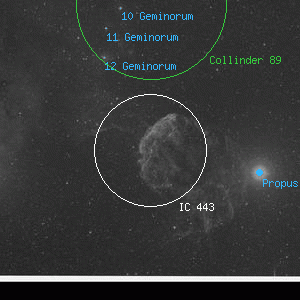IC 443

Overlaid DSS image of IC 443, 120' x 120' with north at top and west to the right
Aladin viewer for the region around IC 443
Jellyfish Nebula
Sharpless 248, Sh 2-248, 3C 157, LBN 844, LBN 189.13+02.97
Sharpless 248, Sh 2-248, 3C 157, LBN 844, LBN 189.13+02.97
| Type | Supernova Remnant |
|---|---|
| Magnitude | 12 |
| Size | 45' x 25' @ 170° |
| Right Ascension | 6h 18' 3" (2000) |
| Declination | 22° 39' 36" N |
| Constellation | Gemini |
| Description | F, narrow curved |
Observing Notes
Harold Corwin
IC 444 and IC 443. Since I wrote about these two last in 2003, I've found Barnard's discovery paper -- it is in "Astronomy and Astro-Physics", Vol. 8, No. 3, page 177, 1894. Note that this is not "Astronomy and Astrophysics", the European journal that appeared in the late 1960s, but is an American journal published for a few years around 1900.
My current interest in this was piqued by a Christmas Day 2014, note to the amastro list by David Knisely asking just what IC 444 is. That inspired me to dig out Barnard's paper. Here is what Barnard has to say in a postscript to his paper:On another photograph taken Feb. 1, 1894, with 2h 10m exposure, the 9m.5 star BD+23 1313 is found to be closely nebulous, a very small dense nebulosity gives it a fuzzy appearance. This nebulosity is heaviest south and following. The place of the star for 1885.0 is α = 6h 11m 35s.8 δ = + 23° 19'.3The first object that is IC 444, the second is IC 443, a well-known supernova remnant.
On this same plate is a faint narrow curved nebulosity in about, 1860.0, α = 6h 8m δ = + 23° 0' It is nearly 1/2° long, extending north and south and convex to the east.
There are two mistakes here. First, the BD star is actually BD+23 1301 = 12 Gem. Barnard caught the mistake and corrected it in his Milky Way Atlas where he specifically mentions IC 444. Second, the equinox he gives, 1885.0, should actually be 1855.0 (see the BD itself to confirm this).
Checking Barnard's Milky Way Atlas, we find these two nebulae on Plate 9, though Barnard mentions only IC 444 (which he calls "N.G.C. I 444"). Again, he centers the nebula on the star BD+23 1301 = SAO 078225 = HD 43836 = 12 Gem.
From all this, we can find what Barnard was referring to in his notes. Wolf is somewhat less precise in his note (from AN 3130, 1892, in a translation by kindly provided by Wolfgang Steinicke):The 2.25-inch Hermagis lens, naturally imaging a larger field than the two bigger lenses, conveniently shows the area near mu and nu Geminorum. There very extended and bright nebulosities can be seen, which, roughly estimated, are centered at α = 6h 14m δ = + 24° and α = 6h 8m δ = + 22° and will be most promising objects.Since the positions (for 1855.0) are quite crude, I assume that Wolf means to include all of the nebulosity. Dreyer was impressed enough by Barnard's more precise position for IC 444 that he adopted it for the IC, but took a mean position for IC 443.
I attempted to follow Dreyer pretty strictly when I first looked at the two nebulae in Scotland in the mid-1970's. Those positions are still in the big table. But after Wolfgang asked about the identifications early in 2003, I estimated positions for the entire extent of the objects. Those are in the table, too. Finally, I've added the positions from Wolf's and Barnard's papers to the position table, too.
I concluded my answer to David with this paragraph:So what can we glean from all of this? First, the nebulae are so big that it probably doesn't matter much where we put the positions as long as we can be sure that we're talking about the correct objects. Second, the positions are dependent to a certain extent on the wavelength in which the observations are made. All of those that I quote here are in the blue or red part of the spectrum, and may not be similar (or even close!) to those from other parts. Third, IC 444 seems to be the huge reflection nebulosity centered as I've noted near 06 21.1, +23 06 [J2000.0], though if you want to take 12 Gem as the center, I would not object.That seems an appropriate place to end this particular note.
Other Data Sources for IC 443
Nearby objects for IC 443
5 objects found within 60'
| 10 Geminorum | 11 Geminorum | 12 Geminorum |
| Collinder 89 | Propus |
Credits...
Drawings, descriptions, and CCD photos are copyright Andrew Cooper unless otherwise noted, no usage without permission.
A complete list of credits and sources can be found on the about page
IC 443